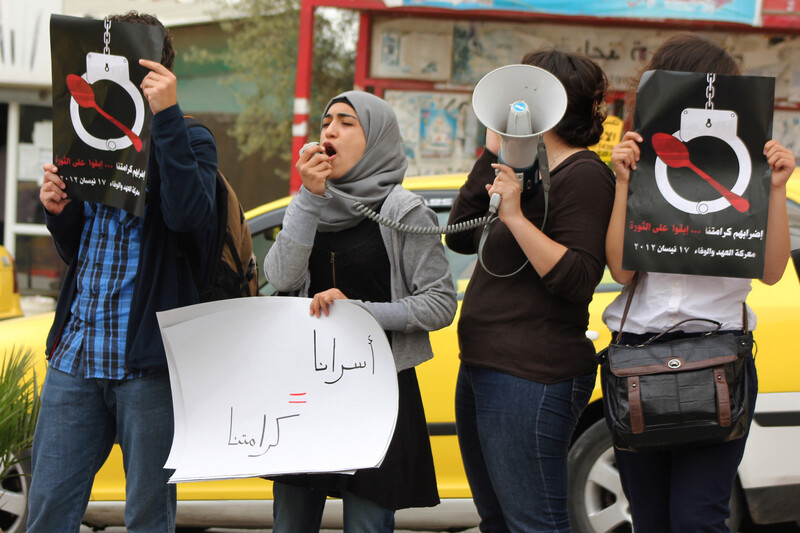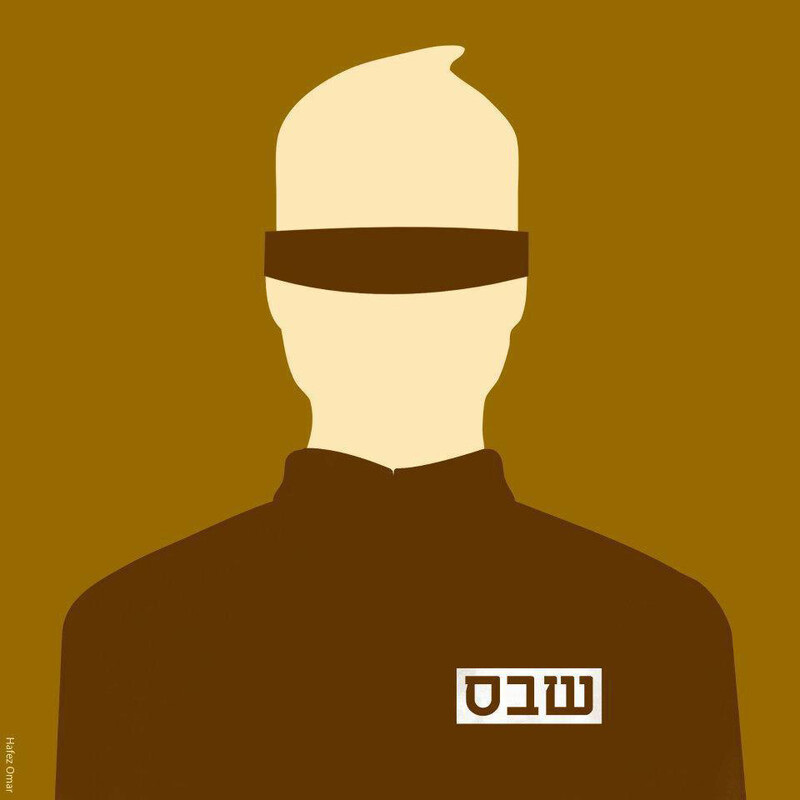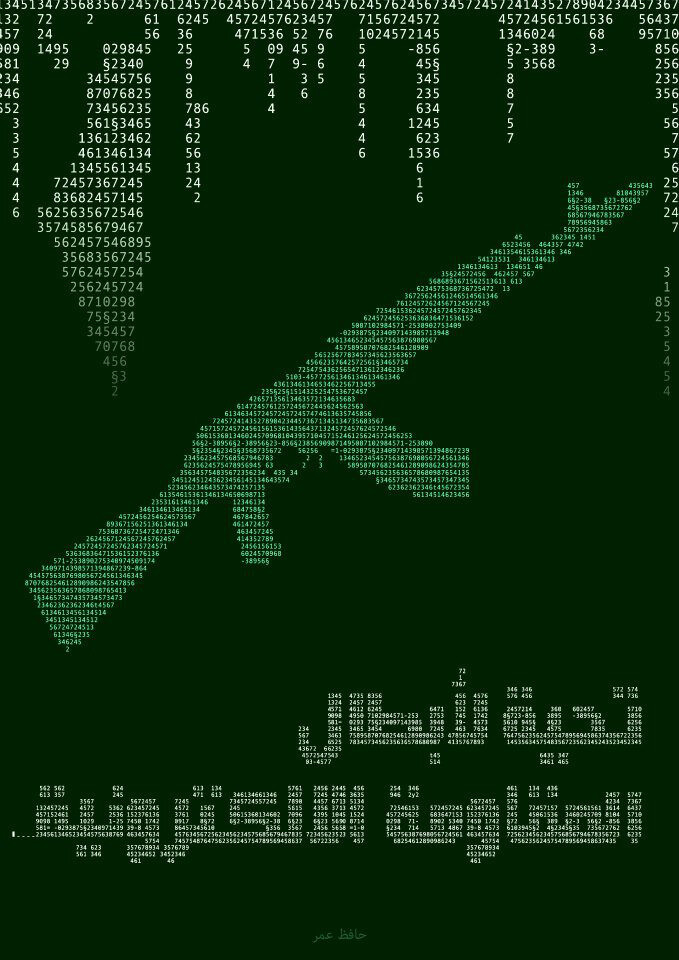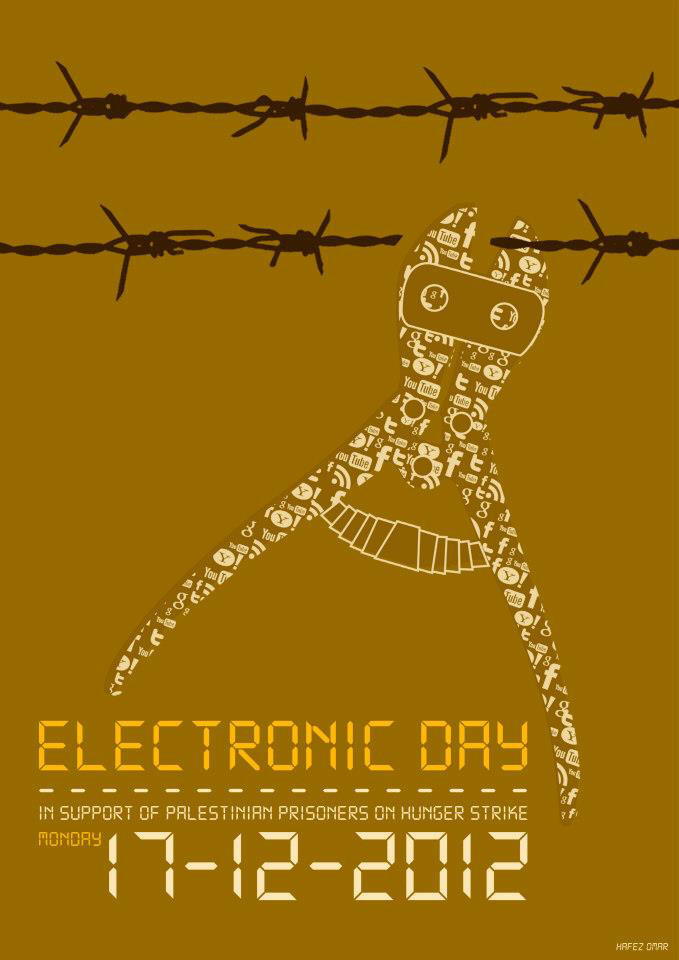The Electronic Intifada Nablus 8 March 2013

Demonstrators in Nablus carry posters with Hafez Omar’s designs in support of hunger strikers, April 2012.
ActiveStillsLast year, Palestinian designer and activist Hafez Omar posted an illustration of an anonymous Palestinian in an Israeli prison on Facebook. Within hours, the image had spread across the Internet.
The image was a simple one: a featureless face with a brown line through it against a green background. Its simplicity was arguably its greatest strength as it provided campaigners hoping to draw attention to hunger strikes being undertaken by political prisoners with a neat illustration.
Based in the West Bank town of Tulkarem, Omar’s work is inspired by the popular resistance movement in Palestine.
Omar recently spoke to The Electronic Intifada contributor Daryl Meador.

Hafez Omar’s image of an anonymous Palestinian prisoner became the avatar of countless Facebook and Twitter users.
Daryl Meador: How did you get started in design? Were you educated in it?
Hafez Omar: I was educated in the Fine Arts School of An-Najah University in Nablus from 2000 to 2005. I originally studied interior architecture, but I never worked with it; I always worked with graphic design. In university I was part of the student movement, and I used to draw and design posters for the student political movements. This is how I started; it was part of my engagement with the situation. It was the beginning of the [second] intifada, and in Nablus it was really intense politically and a kind of warfare. Many people got really involved in politics, especially students, because An-Najah is one of the biggest universities in Palestine.
DM: What kind of things did the student movement take part in?
HO: At the beginning of the intifada, the student movement took a big role in the demonstrations that happened. The student movement organized demonstrations at checkpoints, and after that there were internal activities in the university around the intifada and for the different political parties. Each party was trying to mobilize people around its ideology and its approach to the struggle.
I was in charge of publishing a monthly leftist magazine, called Handala. Each month we would write some articles and print some photographs, and each month I would design and edit it.
DM: How was it printed?
HO: We used to photocopy it. We were not a rich group of students, we didn’t have any resources, we basically donated each month to photocopy about 1,000 copies to spread around the university.
DM: Do you still have any copies?
HO: No, when we left Nablus we had to get rid of them, because the Israelis were entering houses and looking for students and if you got caught with that magazine it would be a problem. I think I have a file of one of the designs in my hard drive but no hard copies.
DM: When you do design work now, it’s always related to political situations on the ground. How do you see the relationship between design and political activism?
HO: Well this is an old tradition in Palestine and many places in the world. The discourse is given to the people in many ways, one of the most interesting kinds being posters and political images. In Palestine we have a tradition in making political posters for different parties, and if you look at the history of the Palestinian posters, you can see the differences between the different parties, ideologies, and what were they calling for. So I consider what I do as a continuation of something that happened before. Early in the ’60s, parties began to mobilize people through posters and magazines.

Imagery of armed struggle features prominently in Hafez Omar’s work, as do references to revolutionary posters.
DM: I notice references in the imagery of your work to historical Palestinian posters; is this deliberate?
HO: It’s a kind of statement I’m trying to make, to bring back the old tradition, because the values that these posters stood for are still there. They were used to mobilize people around liberation and return and self-determination. These are still the same goals of the people. But what happened after Oslo, the official discourse has changed from these principles to state building, which is something I stand against. I still believe that we’re not in the proper time and conditions to start this, we’re still under occupation, 70-80 percent of the Palestinian population is still living as refugees in surrounding countries or elsewhere in the world. Settlements, ethnic cleansing, house demolitions continue. I’m trying to bring the memories that were there with these posters with this kind of visual language.
DM: What is some of the specific imagery you take from the historical poster art and why?
HO: One is the image of the full map of Palestine. Politically, there is confusion between the one and two-state solutions and there is a reflection for that in visual communication tools, like when news agencies have a map of Palestine with the West Bank and Gaza, and now with the images used in state-building. So the full map is coming from the history of Palestinian visual communication. Also, images of armed struggle are some of the visual items that I’ve revived from the old posters. It comes under political explanations for what is homeland and what are we fighting for.
Basically, I use these two items but I also try to focus on people over political parties. I have a lot of posters for leaders, but most are approaching people, just as the posters before. Today, political groups are producing posters for allies or members, but I don’t see much poster or visual art that approaches people as Palestinians. What I do should talk to everybody, not just talk to someone.
DM: But now — unlike the 1960s — we have the Internet so posters are physically printed less. Do you always just publish your work online?
HO: Well the nice thing is that I design them and put them online, and people download, print them, and use them in demonstrations. I don’t control that process, sometimes people ask for some printed but generally I just publish online. And I take it as a sign that I’m still with the people when I see people [have] printed and [are] using things that I design. Then I can measure the public atmosphere and opinion about things. This is how I get my posters into a physical status, it’s the people who download and use them.
DM: I remember the brown hunger striker design being used all over my Facebook. Was this one of the most widely used images you made?
HO: Yeah, this was the biggest actually. No one knows the statistics on how much it was shared, but you could see all of Facebook going brown. That was not my most beautiful, but my most successful design.
DM: What does the brown represent?
HO: It’s from the prisons, this is the costume that prisoners have to put on because of the jail administration. They are forced into these clothes, with these logos. A week ago I was visiting my brother in prison and he was wearing this. They have little mattresses where we sit, and they are also the same color. These are the colors the prisoners have to deal with on a daily basis.

Arabic-language poster translates to “Hail The Heroes of the Electronic Resistance.”
DM: How long has your brother been imprisoned?
HO: Eight years; he was sentenced for nine years so he will be out next year.
DM: Why is your Facebook page called Hitan, the Arabic for walls?
HO: When I used to be a little kid, this was how I learned. We didn’t have an education system about Palestine or the political life. It was the first intifada and I used to walk to school and look at the walls, at the posters and the graffiti. It wasn’t street art, but more like a communication tool. From there I learned about the political parties at a young age. The flag of Palestine was forbidden, the Israelis used to control that. So the walls were always important as a communication tool. So my Facebook page is a kind of homage to this tradition in Palestine.
DM: One of the most recent designs you made was for Bab al-Shams (the tent “village” set up by Palestinians in protest at Israeli settlements), how were you involved in that?
HO: The guys called me a week before and asked for a design for this popular resistance camp, which had nothing to do with Bab al-Shams. And they gave me like zero information. Actually it was cover for them, they called for that camp as a cover for their action. Because at the last moment they changed all of their plans and went to Bab al-Shams and called for a Palestinian village. But I didn’t know before. So it was Friday, I woke up and I saw the news and that the same guys from the popular resistance camp did Bab al-Shams, so I understood at that moment what I should do for that event. I made that poster that morning. Then I went Saturday evening to join the guys in Bab al-Shams; we were evacuated and I got my nose broken, my leg badly injured and had to stay home for two to three weeks.
DM: The Israeli “public relations” machine is attempting to stifle Palestine having an image that people around the world can relate to. As a designer, are you targeted by Israel?
HO: I don’t know if I get targeted because of the posters, because other than the posters I’m so active in the movements so I can’t differentiate. Sometimes I get harassed because of posters I make talking about the Palestinian Authority — that I can tell. Once I was beaten by the PA, but this was because I was in a demonstration. So again it’s hard to tell [what I am being targeted for].
Facebook is so open that it’s hard for Israel to stifle image-making there. They still use social media in similar ways, trying to build images for themselves. In the last war on Gaza they had a big failure, though. They worked as an institute that hires designers and writers to advocate, while the Palestinian part was individuals, normal people who were not being paid. People in the world believed our narrative because it was more natural.

Hafez Omar’s images kept the hunger strikers’ cause visible on social media.
DM: Sometimes there is a theme in your posters about digital resistance, like one with an image of a rifle made up of digital code.
HO: In that one specifically, which says “Hail The Heroes of the Electronic Resistance,” I was talking about the hacker who hacked Israeli banks and financial systems. It was a salute to this. But what he did is electronic resistance because he caused physical damage. But what I do comes at the back of the movement, I don’t actually make a physical change, but I encourage and mobilize. So I don’t consider my work to be the same as people who are throwing rocks in the streets and going to demonstrations. It’s support for them, but you can’t say it is electronic resistance. Visual communication inspires people to think, but then it is their decision to act.
DM: You used to work for al-Mahatta Gallery in Ramallah, which was the first professional arts exhibition space in Ramallah. Can you talk a little about the gallery and fine art in Palestine?
HO: I initiated the place with a bunch of friends, maybe six years ago, and I worked as projects director for the gallery for a year, and then I quit. I decided to get off the NGO [non-governmental organization] scene in Palestine because it’s all part of the neoliberal policies that are trying to make people forget the realities of the occupation. Al-Mahatta is a really nice initiative, but I decided to quit the NGO scene.
In general, I think the cultural scene in Palestine doesn’t have any relation to the Palestinian reality. Palestinian art today is not produced for the Palestinian people. It’s either produced about them, or it doesn’t have any relation but is produced inside Palestine, so it becomes something sexy.
The Palestinian people are stuck with the failed Oslo project, and the Israelis are building more settlements, confiscating more land, killing more people. And the Palestinian people still don’t have a new project, and they’re scattered and not united. They don’t have a way to design a new national strategy. I think that is reflected in the cultural scene. Everyone is doing whatever they want, there is no national cultural scene.
Everyone is running after his own or her own project. I think once there is a new Palestinian movement that people are mobilizing around, then you will see the culture change. For me, in this crazy panoramic scene, I’m just trying to show that the movement isn’t dead, it’s not completely neoliberal and apologetic to the West. I’m trying to say that we’re still trying to produce art for the people, that approaches the people and makes them think and challenges what is happening.
Hafez Omar’s work can be seen on his Facebook page: www.facebook.com/hitancom.
Daryl Meador is a recent graduate of the School of the Art Institute of Chicago who is currently living and volunteering in Nablus.





